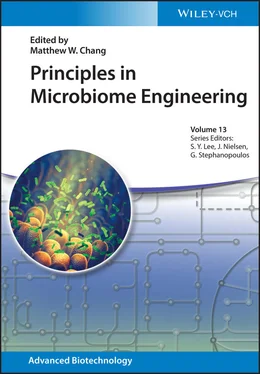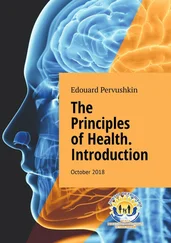Principles in Microbiome Engineering
Здесь есть возможность читать онлайн «Principles in Microbiome Engineering» — ознакомительный отрывок электронной книги совершенно бесплатно, а после прочтения отрывка купить полную версию. В некоторых случаях можно слушать аудио, скачать через торрент в формате fb2 и присутствует краткое содержание. Жанр: unrecognised, на английском языке. Описание произведения, (предисловие) а так же отзывы посетителей доступны на портале библиотеки ЛибКат.
- Название:Principles in Microbiome Engineering
- Автор:
- Жанр:
- Год:неизвестен
- ISBN:нет данных
- Рейтинг книги:5 / 5. Голосов: 1
-
Избранное:Добавить в избранное
- Отзывы:
-
Ваша оценка:
- 100
- 1
- 2
- 3
- 4
- 5
Principles in Microbiome Engineering: краткое содержание, описание и аннотация
Предлагаем к чтению аннотацию, описание, краткое содержание или предисловие (зависит от того, что написал сам автор книги «Principles in Microbiome Engineering»). Если вы не нашли необходимую информацию о книге — напишите в комментариях, мы постараемся отыскать её.
Provides an overview of the techniques and applications insight into the complex composition and interactions of microbiomes Principles in Microbiome Engineering
Principles in Microbiome Engineering
Principles in Microbiome Engineering — читать онлайн ознакомительный отрывок
Ниже представлен текст книги, разбитый по страницам. Система сохранения места последней прочитанной страницы, позволяет с удобством читать онлайн бесплатно книгу «Principles in Microbiome Engineering», без необходимости каждый раз заново искать на чём Вы остановились. Поставьте закладку, и сможете в любой момент перейти на страницу, на которой закончили чтение.
Интервал:
Закладка:
Patients suffering from IBD experience due to long‐term incidences of tissue inflammation on the dorsal end of the GI tract [193] that can be divided into Crohn's disease (CD) and UC. The dietary habits of individuals can either prevent or increase the risk of developing IBD [193]. A westernized diet abundant in fat and protein increases the risk of developing IBD [194], while fiber‐rich diet was found to lower the risk of developing IBD in rats [195, 196]. As discussed in Section 1.2, a fatty and protein‐rich diet was found to enrich Proteobacteria and deplete Firmicutes and Bacteroidetes involved in the biosynthesis of butyrate production [197–199]. These reduced levels of SCFAs in the large intestine are primarily attributed to preventing bowel inflammation [200, 201]. The use of FMT to enrich butyrate‐producing microbes was found to recover the microbiome balance and alleviate IBD symptoms.
There are various approaches to treat CD, where the use of exclusive enteral nutrition (EEN) [164, 191] has been used as first‐line therapy to treat pediatric patients in some countries and regions [202, 203]. A study involving 114 CD patients below the age of 12 showed an approximately 88% remission rate when subjected to EEN [204]. Another study compared oral and continuous enteral feeding of EEN to alleviate symptoms in both groups [205]. The mechanism of EEN‐induced CD remission is unclear where a variation of EEN showed that the composition does not play a direct role in the recovery process [164]. It is hypothesized that EEN triggers anti‐inflammatory molecule production, intestinal barrier restoration, and recovers microbiota perturbation [191, 206]. It was found that EEN decreases microbiome diversity, triggering enrichment of certain populations in the microbiota [207–209]. Despite variations in the enriched population, EEN does certainly affect the microbiota populations and in turn change the microbiome landscape.
Other nutritional elements such as amino acids, fibers, vitamins, and fatty acids can influence IBD pathogenesis. Some studies showed that glutamine‐ and arginine‐supplemented diet conferred improved protection against dextran sulfate sodium (DSS)‐induced colitis in a murine model [210, 211]. Prebiotic fibers can attenuate IBD symptoms in mice model [195, 212] through regulating intestinal bacterial composition and synthesis of anti‐inflammatory by‐products, such as SCFAs [193, 213, 214].
1.3.3 Cancer
Many studies concluded that the microbiota plays a role in cancer pathogenesis in humans. It is further demonstrated that the dietary nutritional content facilitates the behavior of the microbiome. Prebiotics‐containing fiber (soluble and insoluble) helps to move the bowel by bulking up the intestinal lumen and absorbing carcinogens such as nitrosamines, thus limiting the contact time of the carcinogens to the GI epithelium tissue. These fibers also house the SCFA‐producing microbes, enriching the Gram‐positive anaerobic Firmicutes population and providing the substance for microbial fermentation [215–218]. The two most abundant butyrate‐producing Firmicutes in the human colon are E. rectale/Roseburia spp. and F. prausnitzii . E. rectale/Roseburia spp. belongs to the Clostridium coccoides (or Clostridial cluster XIVa) cluster, and F. prausnitzii belongs to the C. leptum (or Clostridial cluster IV) cluster [219–222].
The SCFA butyrate can prevent gut tissue inflammation and suppress cancer cell motility by deactivating Akt/ERK signaling pathway of histone deacetylase in colorectal cancer and lymphoma cancer [223]. Butyrate also exerts its anticancer activity by interfering with the mitochondrial and exogenous apoptotic pathways through regulating oncogenic signaling molecules through microRNAs and methylation [224, 225]. On top of generating butyrate, these bacteria can produce other metabolites such as lactic acid and formic acid that can further exert anticancer activities [226].
Cruciferous plant–rich diet was also found to help in the prevention of colorectal cancer. Cruciferous vegetables are enriched with glucosinolates, a precursor to the anticancer agent isothiocyanates. These glucosinolates require to be catalyzed by the enzyme myrosinase to form its isothiocyanate derivatives. A study showed that cruciferous‐rich and fruit‐rich diet enriches certain groups of Actinobacteria, Firmicutes , and Bacteroides that have weak myrosinase‐like properties [227]. Other approaches to augment the myrosinase activity were achieved using engineered microbes such as E. coli Nissle 1917 [228]. Other means of dietary regulation also reduce the risk of developing cancer by the displacement of pathogens associated with cancer pathogenesis. Colon cancer patients were found to have an enriched population of Fusobacterium nucleatum compared to healthy test subjects detected in both colorectal biopsies and patient stool samples [229–233]. F. nucleatum from the phyla Fusobacteria is a Gram‐negative non‐spore‐forming bacilli that is strictly anaerobic and is usually found in the mouth, playing a role in various diseases such as periodontitis, appendicitis, gingivitis and invasive infections in the other organs. Studies showed that F. nucleatum exerts the cancer pathogenesis through the interaction of three biomolecules located on the surface of the microbe: lipopolysaccharide (LPS), adhesin A (FadA), and fusobacterium autotransporter protein 2 (Fap2) [234]. Fiber‐enriched and low‐fat diet can reduce the risk of F. nucleatum ‐positive colorectal cancer through the displacement of the pathogen from the gut; however, the dietary change does not show any significant improvements in F. nucleatum ‐negative cancer patients [235]. These studies suggest the role of diet pattern in displacing F. nucleatum, thus negating the risk of colorectal cancer development, showing the relationship between diet, microbiome, and cancer pathogenesis.
1.3.4 Psychological Disease
Increasing studies on the brain–gut–microbiome (BGM) axis describe the bidirectional interactions between the central nervous system, gastrointestinal tract, and gut microbiota [236, 237]. Increasing evidence has proposed that this axis contributes largely to pathologies of some psychological diseases, such as autism spectrum disorder (ASD) [237, 238], Parkinson's disease (PD), and Alzheimer's disease (AD) [239, 240]. This section will discuss the dietary effects on ASD and neurodegenerative diseases.
1.3.4.1 Autism Spectrum Disorder
ASD is a neurodevelopment disorder that influences the social behavior and communication of afflicted individuals throughout their lifetime [241, 242], where ASD severity is linked to the intestinal microbiota and gastrointestinal symptoms [238, 243]. Studies on isolated fecal bacteria from ASD patients revealed microbial dysbiosis resulting in the enrichment of Clostridium, Lactobacillus , and Desulfovibrio species; and decreased Bacteroidetes/Firmicutes ratio [244–247]. Carbohydrate‐degrading bacteria from the Prevotella, Coprococcus , and unclassified Veillonellaceae genera showed lower abundance than healthy people [248]. Despite this observation, the fluctuations of specific bacterial species from different studies are inconsistent, thus proving a challenge to determine the role of bacteria dysbiosis in the pathogenesis of ASD [238]. Clinical research using specialized diet to alleviate ASD symptoms has been studied to perturb these microbiota populations. Gluten‐ and casein‐free (GFCF) diet is currently widely prescribed to children with ASD, designed to reduce leaky gut‐causing proteins and facilitate symptom remission [249]. However, there are some inconsistencies in treatment in some small clinical trials [250–252]. Alternatively, the ketogenic diet was found to improve ASD symptoms both in an animal model and small‐sized clinical experiment despite potentially causing ketosis. This is due to the ketogenic diet to compensate the lower Firmicutes to Bacteroidetes ratio and increase A. muciniphila in mice of ASD [253]. While showing much success in mice, the detailed mechanism linking in a ketogenic diet, gut microbiota, and ASD remains unclear due to the lack of appropriate animal models that mimics the human BGM [254]. In addition to altering dietary composition, probiotics, such as Lactobacillus and Bifidobacterium , have been found to improve ASD behavior while treating the ASD‐linked gastrointestinal symptoms [255, 256].
Читать дальшеИнтервал:
Закладка:
Похожие книги на «Principles in Microbiome Engineering»
Представляем Вашему вниманию похожие книги на «Principles in Microbiome Engineering» списком для выбора. Мы отобрали схожую по названию и смыслу литературу в надежде предоставить читателям больше вариантов отыскать новые, интересные, ещё непрочитанные произведения.
Обсуждение, отзывы о книге «Principles in Microbiome Engineering» и просто собственные мнения читателей. Оставьте ваши комментарии, напишите, что Вы думаете о произведении, его смысле или главных героях. Укажите что конкретно понравилось, а что нет, и почему Вы так считаете.












